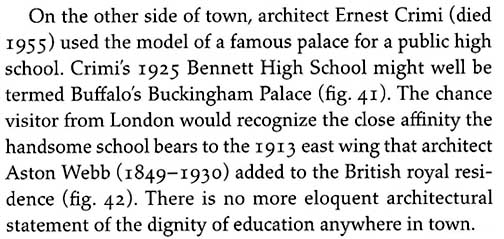Bennett High School - Table of Contents
2006 photos
Bennett High School
2885 Main Street, Buffalo NY
|
Erected: |
1925 |
|
Architect: |
Ernest Crimi |
|
Style: |
Georgian Revival |
|
Namesake: |
Lewis J. Bennett |
Buckingham Palace, London, 2016 photo  Francis R. Kowsky, "Reading Buildings in Buffalo," in Building Buffalo: Buildings From Books, Books From Buildings, Buffalo & Erie County Public Library, Buffalo NY 2017, p. 61. |
|
Postcard |
|
||
|
|
|
|
|
|
Foliated wreaths decorate spandrel panel |
|
|
|
North pavilion |
||
|
|
Bennett High School is named after Lewis J. Bennett, a civic leader in Buffalo who donated the land for the school and for All High Stadium, as well as the land for three churches in Central Park.
The $1.7 million dollar building first opened its door in September 1925 when it welcomed the largest freshman class in the history of Buffalo -1150 students. Total enrollment that year was 2100. Ten years later the number had grown to 3200.
Charles Elbert Rhodes became the first principal of Bennett and served for eight years. A graduate of Princeton University, Mr. Rhodes was pastor of Central Presbyterian Church before becoming an educator. He started the Bennett Beacon (yearbook) and chose the school's motto, Optima futura - The best is yet to be.Central Park and Bennett High School
Central Park was developed by Lewis J. Bennett, the president of the Buffalo Cement Co., whose quarry was located behind the school bordering Amherst Street.
Bennett arrived in Buffalo in 1866.
Bennett purchased 200 acres in Central Park. Central Park was originally a suburb of Buffalo. Its boundaries were Main, Woodbridge, Parkside, Linden, Starin, and Amherst streets. Many of the streets in Central Park were named after Bennett's family and friends.
Two principal factors for the development of the area were the proximity of the Olmsted & Vaux-designed Delaware Park and the completion of the 1860-1882 Belt Line Railroad, which enabled Buffalo to boast more train track than any city in world! The only remaining Belt Line station of the original 19 is at Starin & Amherst.
Bennett built first house in Central Park for himself . He hired prominent Buffalo architect Milton Beebe to design a 24-room house at 354 Depew, located just north of Burke Park. (The house was demolished in 1935 and replaced by 12 lots. Mrs. Bennett then moved to the Campanile).
Bennett also built a clubhouse at Starin & Linden (now a vacant triangle). He also planted 1200 elm trees. To insure that large houses would be built, he provided free (large) foundations on corner lots.
Deed restrictions for Central Park were more stringent than Buffalo's, e.g., no commercial R3 businesses allowed. Only one dwelling and one barn per lot (with eleven exceptions) were allowed.
